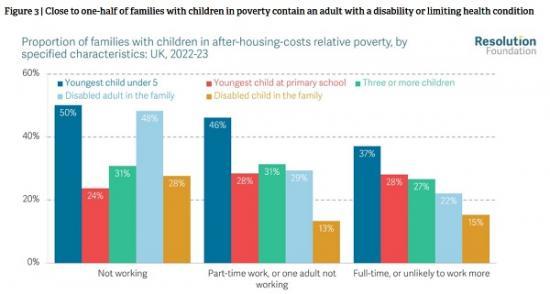Reducing Child Poverty In Britain Today Will Require Greater Support For Working Parents
6th January 2025

Single-earner couples have seen their risk of falling into poverty rise by a third since 2000.
Rising parental employment over the past two decades has switched the focus of Britain's child poverty challenge from tackling workless households to supporting working families, with many kinds of working families now facing a greater risk of poverty than at the turn of the millennium, according to research published today (Monday) by the Resolution Foundation.
Working poverty out notes that the last Labour government reduced relative child poverty significantly - down by the equivalent of 600,000 children between 1998-99 and 2008-09 - with rising parental employment playing a key role. Critically, single parent employment rates increased from 52 per cent in the mid-2000s to 66 per cent by 2022.
However, as the current Labour Government prepares a new child poverty strategy for the decade ahead, the authors note that Britain's employment and poverty landscape have changed drastically, necessitating a different approach.
The share of families in poverty where no-one works has fallen from 50 per cent in 2000 to 30 per cent in 2022. Those families that remain workless today face significant barriers to work. For example, three-quarters have a primary school-aged child, half have a child under the age of five, close to half have an adult with a disability or long-standing limiting health condition, and three-in-ten have a child with a disability.
Supporting these families into employment will require specific support, say the authors, rather than expecting them to move into work as their children get older, particularly where there are health issues affecting adults or children.
With most families in poverty in Britain today having at least one person in work but with scope to work more (55 per cent, up from 43 per cent in 2000), the report emphasises that supporting working families to earn more will also need to be a focus of any child poverty strategy fit for the 2020s.
While the risk of living in poverty for working families has fallen for lone parents in part-time work (from 43 to 34 per cent since 1998), and only increased marginally from a low base for so-called ‘one-and-a-half' earner couples (from 11 to 14 per cent over the same period), it has increased substantially for couples where only one adult works (from 30 to 40 per cent).
Looking at what can lift working families out of poverty, the report finds that enabling second earners to work is likely to have the biggest impact: a fifth of working-poor families who see a second earner move into work are able to escape poverty.
The report shows that more can be done to support existing workers to lift their families out of poverty. Increasing work by five hours or more a week or raising hourly pay by ten per cent or more would both increase families' chances of escaping poverty by seven percentage points.
But the report warns of barriers preventing parents from progressing. Practical constraints like childcare (especially for school-aged children outside of school hours and term-time) and local transport links will need to be addressed. The report does note that the Government's existing labour market reforms to boost worker power and prevent exploitative zero hours contracts should help reduce the risks of switching jobs so parents can attain more hours or a higher wage.
Finally, the authors note that any focus on employment will need to be complemented by action on housing and benefits, with recent Resolution Foundation research finding that high housing costs are pushing half of families in private rented accommodation below the poverty line.
Mike Brewer, Interim Chief Executive of the Resolution Foundation, said:
"Getting more parents into work played a major role in reducing child poverty during the last Labour government.
"But Britain today is very different - most families in poverty have at least one person in work, with those that are still workless facing significant barriers to employment.
"The Government’s new child poverty strategy will need to confront these challenges, which require action across a broad front. As well as the obvious moves, like boosting childcare support - particularly for primary-school-aged children - and making it easier to commute between workplaces, schools and nurseries, strengthening workers’ rights should help reduce the risks involved in changing jobs.
"With many of the ‘easy gains’ on poverty reduction achieved, the Government will need deep pockets, and action on multiple fronts across employment, housing and benefits, to lift significantly more children out of poverty."
Read the full report HERE
Pdf 9 Pages
